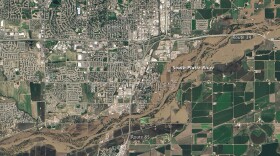Six months after September's devastated much of the Front Range, many areas hit hard have mostly returned to normal. That's not the case everywhere. For residents of Big Elk Meadows, getting back home has been a slow process.
Collin Isenhart and his family were among those , a small community nestled in the mountains between Lyons and Estes Park.
The main road into the area was so damaged as to be impassable. It took about two months to restore electricity and to get temporary roads in place.
"People are starting to come back now," Isenhart says. "People who don鈥檛 have to 鈥� like me 鈥� live in the valley and travel down every day, they could kind of come up and live up there again."
The biggest obstacle facing the small community of 160 residents isn鈥檛 the lack of utility service or the damage to the roads 鈥� it鈥檚 the decimation of the community鈥檚 water system.
"We have a series of lakes 鈥� or we used to have a series of lakes 鈥� and we鈥檇 draw water from the lakes, and we had a distribution system," Isenhart says.
Big Elk Meadows' water went through a filtration plant and then was distributed to all the houses. The system depended on a group of small earthen dams, which were .
Homeowners now are installing individual water tanks in their homes to get by until the infrastructure can be repaired. Isenhart anticipates that will be sometime in the fall.
"Now it鈥檚 just a matter of getting the engineering done and borrowing some money," Isenhart says, "because we鈥檙e looking at probably $6 million worth of funds 鈥� a portion of that FEMA will help us with, and then I think 25 percent of it, we鈥檒l have to pay."
The and volunteers from within and outside the community have been hard at work. One wild card 鈥� what happens when all the snow starts melting?

"We are really curious as to what that鈥檚 going to be like," says Isenhart. "I don鈥檛 expect it to be anything like the initial incident, of course, but鈥� our focus, I guess, is to get as much debris out of the rivers as we can, so when the water comes down it can flow through and doesn鈥檛 get hung up on stuff. There鈥檚 a lot of Forest Service and some of the private land that we own, so all of that we鈥檙e trying to help out and get cleaned up."
In addition to , people are focused on cleaning out the lakes and rebuilding the water system. There鈥檚 still much to be done for individual homeowners as well.
"We鈥檝e got volunteers from the fire department and the community that are helping organize groups that are stripping drywall and carpeting out of the homes, cleaning mold, trying to patch the drywall, and things like that," Isenhart says.
Because so many of the hardest-hit areas have recovered in the months following the flood, Isenhart understands that most Coloradans have put the disaster behind them.
But the reality is very different.
"As soon as you head west鈥� to any of the mountain communities west of Boulder here, you鈥檒l definitely, immediately notice as soon as you hit Lyons that鈥� it鈥檚 not over."








